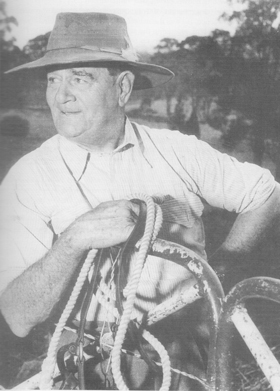Tom Quilty Gold Cup - A Brief History
 Tom Quilty
Tom QuiltyEndurance riding has been an organised sport in Australia since 1966. Reports of the Tevis Cup endurance ride in the USA began reaching Australia. One person inspired by the concept of a long distance competitive horse ride was R. M. Williams, editor of Hoofs and Horns, a pioneer horse magazine in this country. It had a wide circulation and printed stories and reports of the Tevis Cup. An invitation was extended through the magazine for people interested in conducting Australia’s own 100 miles in one day ride, to attend a meeting at the Australia Hotel, Sydney on Tuesday 5th April, 1966 to discuss the possibility of organising such a ride in Australia.
Twenty-three people attended to consider two submissions, one from the Mallee district of Victoria and the other from the Hawkesbury district, near Sydney, New South Wales. History shows that the Sydney offer was accepted, being a relatively central, scenic location, with the support of the University of Sydney’s Rural Veterinary Centre, Camden. A committee was formed to organise the first 100 mile ride, modelled on the successful Tevis Cup ride in the USA.
Despite much opposition from animal rights groups and the Royal Society for the Prevention of Cruelty to Animals, the event went ahead, thanks largely to the strong support from Professor David Hutchins. His professional standing was so high that the RSPCA could not engage a veterinarian who would oppose him. Professor Hutchins based the veterinary standards for the conduct of the ride on those used by the Tevis Cup, plus the results of some practical work done by two of his final year veterinary students. Horses in training for the ride were ridden over set distances and times, to help determine suitable veterinary standards. These results confirmed the standards being used in the American rides of the time. It was mandatory that the strictest of veterinary controls be applied to the ride, in the best interests of the horses, in order to show the budding sport as a professionally run event, and not an exercise in cruelty.
R. M. Williams wrote to his friend Tom Quilty (right), a great horseman and cattleman in the Kimberly area of Western Australia. Williams asked for his support for the 100 miles ride, and Quilty donated $1000. This was used to make a gold cup, the prize for the winner of the event. This is a perpetual trophy, and the ride was named the Tom Quilty Gold Cup in his honour. The original Gold Cup now resides in the Stockman’s Hall of Fame, in Longreach, Queensland.
Cash prizes were originally offered as incentive for competitors, however, at the last minute it was pointed out that local by-laws prohibited racing for money, over public roads. A meeting of riders and officials was held, and all resolved to ride for the satisfaction of simply participating, and for the honour of wearing the handsome silver Quilty buckle. The Quilty buckle is still a highly regarded prize. Endurance riding in Australia continues to be an amateur sport, with no provision for prize money.
The winner of the first Quilty was Gabriel Stecher, an engineer from Victoria, who rode his Arabian stallion ‘Shalawi’ bareback the full 100 miles, plus a few more miles when he took a wrong turn! Several riders retired their horses, when they felt them too tired to continue, but there were no major veterinary problems. The first Quilty was declared a success, and the following day, plans were made to form an Australian Endurance Riders Association, to devise a set of rules and adopt the veterinary standards as advised by Professor Hutchins and his assistant Bob Rawlinson.
The sport grew over the next several years, with fifty mile rides being conducted in all the states, and the annual Tom Quilty Gold Cup 100 mile ride in NSW. Endurance riding began to be accepted as part of the horse scene, with Hoofs and Horns magazine giving the sport coverage. In 2001, the national calendar has around 200 events, with about 2500 members of endurance associations.
The Quilty was considered as the National endurance ride, with its location being fairly central for riders, except for those in Western Australia. In 1986, a referendum of all endurance riders in Australia resulted in the decision to move the Quilty from state to state in rotation. This gave endurance riders in each of the six states to have the chance to compete in the Quilty in their home state, and not have to travel large distances to compete.

